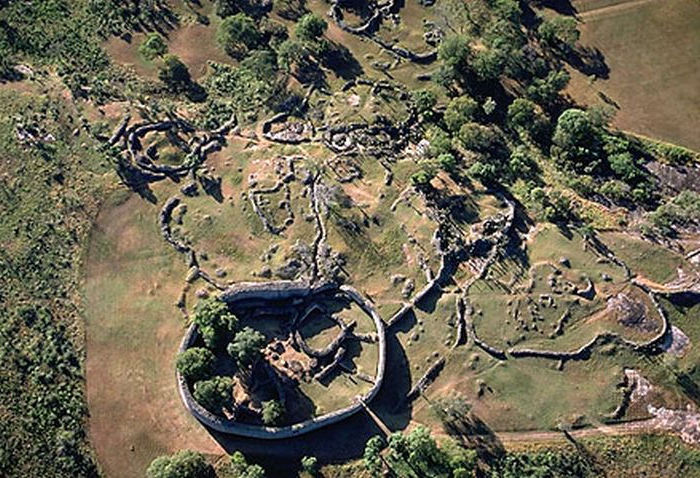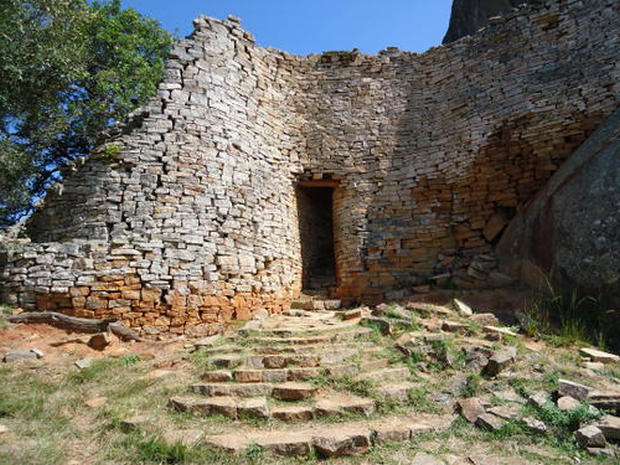For centuries, the largest stone monument in sub-Saharan Africa has puzzled historians and archaeologists. To account for its origins, various people have coupled it with such evocative names as King Solomon and the Queen of Sheba, but the ruins of Great Zimbabwe retain their secret to this day. There were many thriving civilizations in Africa long before the arrival of Arab traders, who settled there in the 11th century. Several hundred sites of stone ruins have been discovered between the Zambezi and Limpopo rivers, but of these the most impressive is Great Zimbabwe, from which the modern state (formerly Southern Rhodesia) takes its name.
Zimbabwe is an anglicized form of an African word meaning ‘stone houses’, for the ruins are built in stone, which is not a common building material in Africa. The Great Zimbabwe complex is scattered over 200 acres (80ha) at the head of a valley. Dominating the site is the Great enclosure, bounded by an elliptical outer wall 830ft (250m) in circumference. Three narrow gaps in the wall lead to an interior divided by other stone walls, passages, and rooms. The most intriguing feature of the superb example of dry-stone masonry, it stands 36ft (11m) high with a base circumference of 57ft (17m). The shape resembles the style of granary built by farmers of the local Shona tribe but, since it is completely solid, its purpose has totally baffled archaeologists.

About half a mile north of the Great Enclosure, on top of a granite hill, is another complex of ruins known as the Hill Fortress, or Acropolis. This was also built using dry-stone walling. Narrow staircases, just wide enough for one person at a time, lead into a labyrinthine interior consisting of a series of small enclosures. Several soapstone birds, believed to have some religious significance, were found in one of these inner sanctuaries; the bird, which resembles an eagle, is now Zimbabwe’s national emblem.

Portuguese traders, who came to Africa in the 16th century in search of gold, were the first Europeans to hear of Great Zimbabwe. A Portuguese historian, Joao de Barros, published a book in 1552 describing rich gold fields there, and great buildings made of dry stone called ‘simbaoe’ by the local inhabitants.
About 40 years later a Portuguese missionary, Joao dos Santos, referred to these same buildings in his writings, reporting that some Africans believed them to be the ruins of gold mines belonging to the Queen of Sheba or, perhaps, King Solomon. Dos Santos himself thought that these were the gold mines of Ophir, mentioned in the Bible as the source of King Solomon’s gold.
Running parallel to the outer wall of the Great Enclosure is a second wall, creating a narrow passageway. This inner wall is a section of a smaller, earlier one, less skilfully constructed than later parts.

Gold was probably the coinage used for foreign trade in Great Zimbabwe. Its inhabitants were skilled miners and craftsmen, as gold artefacts found there testify. The presence of gold gave rise to the belief that this was the site of King Solomon’s mines, but most of it was plundered in the 1800s.
No Portuguese had actually set eyes on Zimbabwe. They relied instead on tales of its existence recounted by African traders. Nonetheless they thought that they had identified the Biblical land of Ophir, and this idea inspired other Europeans, who perpetuated it in their literature. The Dutch, who had settled in South Africa by the mid-17th century, attempted to find the stone ruins of Ophir but did not succeed.
In 1871, the German geologist Karl Mauch visited Great Zimbabwe and in his detailed account declared it to be the ruins of the Queen of Sheba’s palace. But in 1905, the British archaeologist David Randall-MacIver brusquely dismissed that idea and began to excavate the Great Enclosure and Acropolis. He proposed that, far from being ancient, the complex was started in the 11th century and completed in the 15th. Subsequent archaeological investigation has confirmed this, adding that the actual site was probably established in the third century.

Most experts agree that Great Zimbabwe is African in origin and design, but there is no explanation as to why it was built of stone, rather than the traditional materials of wood and mud. Nearby ruins of mines (from which gold was obtained) indicate that the site was probably the centre of an African mining culture which declined in the 15th century.
British archaeologist Roger Summers, who examined these mines n 1958, concluded that the mining methods were the same as those used in the gold-rich Kolar district of India, suggesting that there had been an influence from that country. The discovery of Arabian, Chinese and Persian artefacts proved that the inhabitants of Great Zimbabwe had contact with the outside world and that they probably traded extensively. Historians have also suggested that in the ninth century Zimbabwe was a slave centre, transporting Africans to Arab lands.
The conical tower at the Citadel of Great Zimbabwe still remains a puzzle till date. Various theories have been advanced as to its purpose, including suggestions that it is a fertility symbol (an idea that derives from its phallic shape), a watch tower or a religious icon.

Although some facts about Great Zimbabwe have been established, they are simply pieces in a jigsaw which is far from complete. The people responsible for the buildings were most likely the ancestors of today’s Shona tribe, but there are few clues as to why the site was abandoned. Real evidence is hard to come by without a written language. So, the great stone ruins stand in their hilltop setting, the only remaining proof of a civilization lost to time.
-end-




































